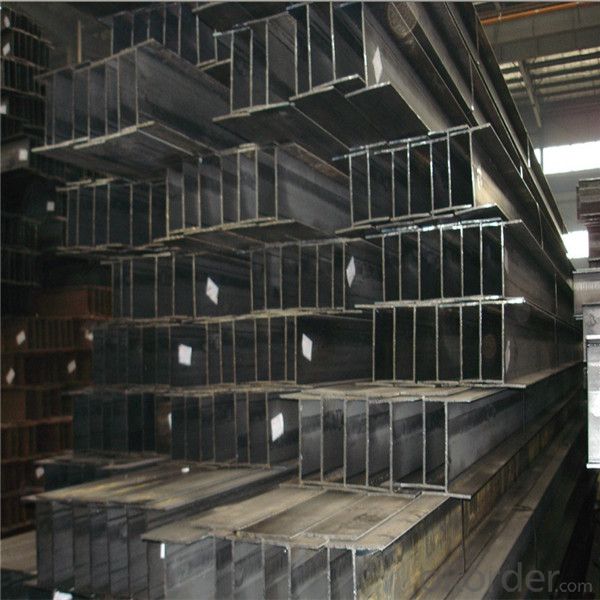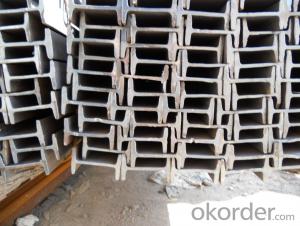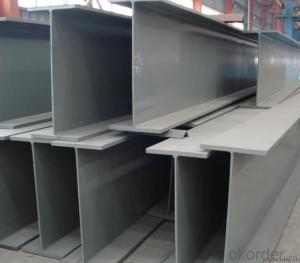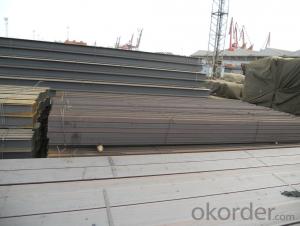Wide Flange H Steel Beam Sizes Good Price
- Loading Port:
- Guangzhou
- Payment Terms:
- TT OR LC
- Min Order Qty:
- 100 m.t
- Supply Capability:
- 120000 m.t/month
OKorder Service Pledge
OKorder Financial Service
You Might Also Like
Item specifice
Quick Details
OKorder is offering H BEAM at great prices with worldwide shipping. Our supplier is a world-class manufacturer of steel, with our products utilized the world over. OKorder annually supplies products to African, South American and Asian markets. We provide quotations within 24 hours of receiving an inquiry and guarantee competitive prices.
We can provide qualify goods,competitive price and speedy delivery.

Products Description
H Type Steel Size and Theoretical Weight | |||||
Size | Theoretical Weight | Size | Theoretical Weight | Size | Theoretical Weight |
|
|
|
|
|
|
(mm) | (kg/m) | (mm) | (kg/m) | (mm) | (kg/m) |
100*50*5*7 | 9.3 | 250*125*6*9 | 29 | 446*199*8*12 | 65.1 |
100*100*6*8 | 16.9 | 250*250*9*14 | 71.8 | 450*200*9*14 | 74.9 |
125*60*6*8 | 13.1 | 294*200*8*12 | 55.8 | 482*300*11*15 | 110.8 |
125*125*6.5*9 | 23.6 | 298*149*5.5*8 | 32 | 488*300*11*18 | 124.9 |
148*100*6*9 | 31.1 | 340*250*9*14 | 36.7 | 496*199*9*14 | 77.9 |
150*75*5*7 | 14 | 300*150*6.5*9 | 93 | 500*200*10*16 | 88.1 |
150*150*7*10 | 20.7 | 300*300*10*15 | 78.1 | 582*300*12*17 | 132.8 |
175*90*5*8 | 18 | 346*174*6*9 | 41.2 | 588*300*12*20 | 147 |
175*175*7.5*11 | 40.4 | 350*175*7*11 | 49.4 | 596*199*10*15 | 92.4 |
194*150*6*9 | 29.9 | 350*350*12*19 | 134.9 | 600*200*11*17 | 103.4 |
198*99*4.5*7 | 17.8 | 390*300*10*16 | 104.6 | 700*300*13*24 | 181.8 |
200*100*5.5*8 | 20.9 | 396*199*7*11 | 56.1 | 800*300*14*26 | 206.8 |
200*200*8*12 | 49.9 | 400*200*8*13 | 65.4 | 900*300*16*28 | 240.1 |
244*175*7*11 | 43.6 | 400*400*13*21 | 171.7 |
|
|
248*124*5*8 | 25.1 | 440*300*11*18 | 120.8 |
|
|
Length=6------12meters | |||||
Packaging & Delivery
Packaging Details: | Packed with waterproof paper and steel banding. |
Delivery Detail: | 15-25 |
FAQ
1. How can I get some samples?
We are honored to offer you samples. New clients are expected to pay for the courier cost. The samples are free for you.
2 Do you have any certificates?
Our products passed inspection of SGS, FDA, and CE Quality is priority! Every worker keeps the QC from the very beginning to the very end, Quality control department especially responsible for quality checking in each process.
3 Can your factory print or emboss my logo on the goods?
Yes, we can print or emboss the logo on the goods or their packing box.
4 What information should I let you know if I want to get a quotation?
1) The specification of products (length x width x thickness);
2) The temper and alloy.
3) The final product you will use to be made
4 It will be better if you can show us the pictures or design sketch. Samples will be best for clarifying. If not, we will recommend relevant products with details for reference.We usually produce goods based on customers
Samples or based on customers’ picture, logo, sizes etc.
- Q:How do steel H-beams resist bending and deflection?
- Steel H-beams resist bending and deflection due to their unique shape and material properties. The horizontal flanges and vertical web of the H-beam design distribute the applied load evenly, allowing it to bear significant weight without significant bending. Additionally, the high tensile strength of steel ensures structural integrity and minimizes deflection under heavy loads.
- Q:How do steel H-beams perform in dynamic loads?
- Steel H-beams are known for their excellent performance in dynamic loads. Due to their structural shape and high strength, H-beams are able to withstand dynamic forces and vibrations, making them suitable for applications where there is frequent movement or variable loads. Their robustness and ability to distribute loads evenly along the beam's length ensure stability and structural integrity, even in demanding dynamic conditions. Overall, steel H-beams are highly reliable and efficient in handling dynamic loads.
- Q:Can steel H-beams be used in the construction of transportation hubs or terminals?
- Yes, steel H-beams can be used in the construction of transportation hubs or terminals. Steel H-beams are commonly used in structural applications due to their strength, durability, and ability to support heavy loads. In transportation hubs or terminals, where large open spaces and long spans are often required, steel H-beams provide a reliable and cost-effective solution for creating strong and stable structures.
- Q:Can steel H-beams be painted or coated?
- Yes, steel H-beams can be painted or coated. The painting or coating process helps protect the steel from corrosion, improves its aesthetic appearance, and can provide additional durability and resistance to environmental factors.
- Q:What are the different finishes available for Steel H-Beams, such as galvanized or painted?
- Steel H-Beams come in a variety of finishes, including galvanized and painted options. Galvanized finishes involve coating the steel beam with zinc to prevent corrosion and rust. This makes them ideal for outdoor or high-moisture environments, such as coastal construction projects. Painted finishes, on the other hand, add a decorative touch and act as a protective barrier against rust and corrosion. They can be customized to match specific aesthetic requirements or stand out for safety purposes. Another option is powder coating, which involves applying a dry powder to the steel beam and curing it under heat to create a durable finish resistant to chipping, scratching, and fading. The choice of finish depends on the application and environmental factors. Galvanized finishes are suitable for outdoor or high-moisture environments, painted finishes are versatile and customizable, and powder coating offers durability and attractiveness. Consider the specific needs of your project when selecting the appropriate finish for Steel H-Beams.
- Q:What are the different types of steel H-beam connections used in airport terminals?
- There are several types of steel H-beam connections commonly used in airport terminals, including bolted connections, welded connections, and moment-resisting connections. Bolted connections involve using bolts and nuts to join the H-beams together, offering ease of installation and disassembly. Welded connections involve permanently joining the H-beams using welding techniques, providing high strength and stability. Moment-resisting connections are designed to withstand bending moments and provide enhanced structural integrity, commonly used in areas with high wind loads or seismic activity. The specific type of connection used in airport terminals depends on factors such as the design requirements, structural loads, and construction techniques employed.
- Q:Are steel H-beams suitable for use in the construction of airports or terminals?
- Yes, steel H-beams are suitable for use in the construction of airports or terminals. Steel H-beams are a commonly used structural element in construction due to their strength and durability. They are designed to withstand heavy loads and provide stability to structures. Airports and terminals require strong structural elements to support large spans, accommodate heavy equipment, and withstand dynamic loads from aircraft. Steel H-beams are capable of meeting these requirements, making them an ideal choice for such construction projects. Additionally, steel H-beams offer several advantages over other materials. They are fire-resistant, have a long lifespan, and require low maintenance. These properties make them a cost-effective option in the long run. Furthermore, steel H-beams can be easily fabricated and erected, allowing for efficient construction timelines. Their versatility allows for flexibility in design, enabling architects and engineers to create customized solutions for the specific needs of airports or terminals. In summary, steel H-beams are suitable for use in the construction of airports or terminals due to their strength, durability, fire resistance, and low maintenance requirements. They offer a cost-effective and efficient solution for creating stable and reliable structures that can withstand the demands of these facilities.
- Q:How do steel H-beams perform in high-traffic areas such as airports or train stations?
- Steel H-beams are an ideal choice for high-traffic areas such as airports or train stations due to their exceptional performance characteristics. Firstly, steel H-beams offer superior structural strength and stability, which is crucial in areas with heavy foot traffic and constant movement of vehicles. They can support heavy loads without bending or warping, ensuring the safety and longevity of the structure. Moreover, steel H-beams have excellent resistance to wear and tear. In high-traffic areas, frequent contact with luggage carts, trolleys, and other heavy equipment can cause significant damage to the infrastructure. However, steel H-beams are highly durable and can withstand this constant impact without compromising their structural integrity. Additionally, steel H-beams are known for their fire resistance. Airports and train stations are public spaces where fire safety is of utmost importance. Steel is a non-combustible material, and H-beams have a high melting point, which means they have a better chance of withstanding fire accidents and minimizing the spread of flames, providing added safety for occupants. Furthermore, steel H-beams are highly customizable, allowing for efficient design and construction in high-traffic areas. They can be fabricated to various lengths, sizes, and shapes, ensuring the structural requirements of the specific location are met. This versatility enables architects and engineers to create innovative and efficient designs that optimize space and accommodate the needs of the area. In terms of maintenance, steel H-beams have a low maintenance requirement, making them cost-effective in the long run. With regular inspections and minimal repairs, steel H-beams can maintain their structural integrity and appearance for many years, even in high-traffic areas. Overall, steel H-beams are the preferred choice for high-traffic areas such as airports or train stations due to their exceptional strength, durability, fire resistance, and customization options. Their performance characteristics make them capable of withstanding heavy loads, resisting wear and tear, and ensuring the safety and longevity of the infrastructure in these bustling public spaces.
- Q:How do steel H-beams contribute to the thermal performance of a building?
- Steel H-beams, commonly used in the construction industry, play a crucial role in enhancing the thermal performance of a building. Firstly, these beams have excellent structural properties, allowing for the creation of larger open spaces and reducing the need for additional supports. This, in turn, optimizes the building's thermal envelope by minimizing the number of thermal bridges. Thermal bridges are areas in a building's structure where heat can easily escape or enter, resulting in energy loss and decreased thermal efficiency. By utilizing steel H-beams, which have a low thermal conductivity, the risk of thermal bridging is significantly reduced. This ensures that the building's insulation and climate control systems can work more effectively, maintaining a comfortable indoor temperature while reducing energy consumption. Moreover, steel H-beams can be combined with other energy-efficient materials, such as insulated panels or double-glazed windows, to further enhance the thermal performance of the building. These materials work in synergy with the H-beams to create a highly insulating envelope that prevents heat transfer from inside to outside or vice versa. Additionally, steel H-beams can support the installation of advanced heating, ventilation, and air conditioning (HVAC) systems. By providing a sturdy framework, these beams enable the efficient distribution of conditioned air throughout the building, ensuring consistent thermal comfort across various areas. Furthermore, steel has a high melting point, making it fire-resistant and contributing to the building's overall fire safety. This quality, combined with the ability of steel H-beams to withstand heavy loads, provides an added layer of protection, ensuring the structural integrity of the building in the event of a fire. In conclusion, steel H-beams have a significant impact on the thermal performance of a building. By minimizing thermal bridging, supporting energy-efficient materials, facilitating HVAC systems, and enhancing fire safety, these beams help create a well-insulated and comfortable environment while reducing energy consumption and ensuring structural integrity.
- Q:What are the common methods for joining steel H-beams in construction?
- Steel H-beams can be joined in construction using various methods. The most frequently employed technique is welding, where the beams are aligned and fused together through arc welding or gas welding. This creates a sturdy and long-lasting connection, ensuring the structural integrity of the beams. Another method involves using bolts to connect the steel H-beams. Holes are drilled into the flanges, and bolts are inserted through these holes and tightened with nuts. This allows for easy disassembly and reassembly if required. Riveting is an alternative method that involves using rivets to join the steel H-beams. Holes are drilled into the flanges and web, and rivets are inserted and secured through hammering or pressing. However, this method is time-consuming and has been largely replaced by welding and bolted connections. In some cases, adhesive bonding can be used to join steel H-beams. High-strength adhesives are applied to the surfaces of the beams, and they are then pressed together. Although not as commonly used as welding or bolted connections, adhesive bonding can be a viable option in certain situations. Overall, welding and bolted connections are the predominant methods for joining steel H-beams in construction. These techniques provide robust and reliable connections, ensuring the stability and integrity of the structure.
1. Manufacturer Overview |
|
|---|---|
| Location | |
| Year Established | |
| Annual Output Value | |
| Main Markets | |
| Company Certifications | |
2. Manufacturer Certificates |
|
|---|---|
| a) Certification Name | |
| Range | |
| Reference | |
| Validity Period | |
3. Manufacturer Capability |
|
|---|---|
| a)Trade Capacity | |
| Nearest Port | |
| Export Percentage | |
| No.of Employees in Trade Department | |
| Language Spoken: | |
| b)Factory Information | |
| Factory Size: | |
| No. of Production Lines | |
| Contract Manufacturing | |
| Product Price Range | |
Send your message to us
Wide Flange H Steel Beam Sizes Good Price
- Loading Port:
- Guangzhou
- Payment Terms:
- TT OR LC
- Min Order Qty:
- 100 m.t
- Supply Capability:
- 120000 m.t/month
OKorder Service Pledge
OKorder Financial Service
Similar products
New products
Hot products
Related keywords



























